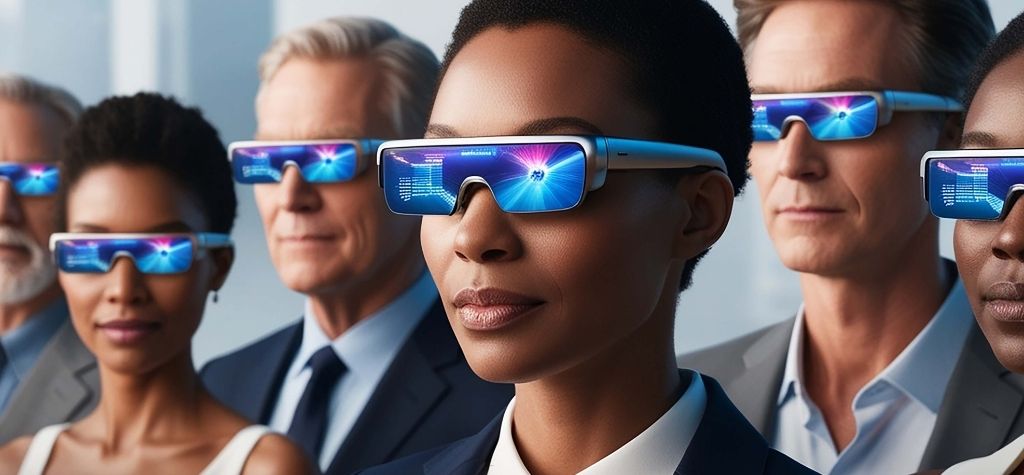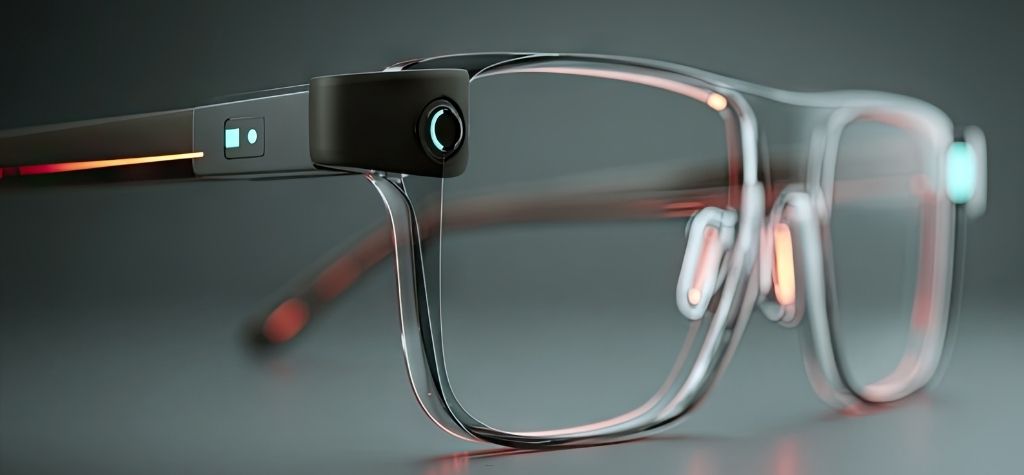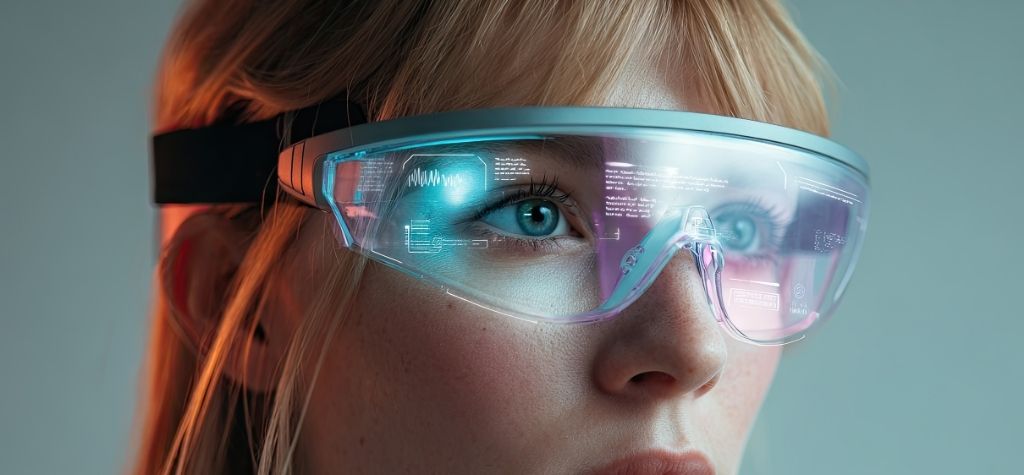A Glimpse of the Future

Imagine waking up, slipping on a pair of sleek glasses and heading into your day without ever reaching for a phone. Messages, maps and real‑time answers appear in front of your eyes, while an AI assistant softly whispers reminders and translation. This isn’t a scene from a science‑fiction movie – it’s a vision that major tech companies and researchers are actively pursuing. Augmented‑reality (AR) smart glasses have been around for more than a decade, but advances in artificial intelligence (AI) and miniaturized hardware could turn them into the next life‑changing gadget. Meta chief executive Mark Zuckerberg, who has invested billions of dollars into AR/VR, said that smart glasses are “very powerful for AI because… glasses, as a form factor, can see what you see and hear what you hear from your perspective”. In other words, glasses offer an AI assistant a direct window into your world, making them a natural replacement for the handheld smartphone.
In this article we’ll break down why AI‑powered glasses could supplant smartphones, explore the technology’s capabilities and limitations, and offer a glimpse into how such devices might shape our daily lives. The writing is intentionally conversational and easy to follow, with short sentences and clear explanations. Whether you’re a tech enthusiast or a curious reader, you’ll discover how the next big shift in personal computing may rest on the bridge of your nose.
What Are AI‑Powered Smart Glasses?

Smart glasses are wearable devices that look like regular spectacles but contain high‑tech features such as augmented reality, voice recognition and AI‑driven capabilities. According to a 2025 article from the Global Tech Council, smart glasses overlay digital information into the real world, use voice control for hands‑free operation, include integrated cameras and microphones, and connect to the internet or other devices. This combination allows them to display digital information, record video or audio and interact with the internet without you having to pick up a smartphone.
Early products such as Google Glass (introduced in 2012) provided a small heads‑up display, but they struggled with clunky design, limited functions and social backlash. Reviewers criticized the “buggy software” that often misunderstood spoken commands, and the device’s conspicuous camera led to concerns about privacy. However, those early missteps taught developers what users didn’t want. Today’s smart glasses are designed to look more like fashionable eyewear, and companies like Meta, Apple and Xreal are working to integrate powerful AI assistants and high‑quality displays.
How AI Transforms Smart Glasses
Generative AI has improved dramatically in just a few years. Since the release of ChatGPT in 2022, “seemingly every tech company” has tried to build digital assistants that can converse, answer questions and control devices. Greg Wayne, research director at Google DeepMind and lead for Project Astra, noted that universal AI agents could “positively impact many aspects of day‑to‑day life” by translating languages, providing real‑time information about the physical world and enabling independence for people with disabilities. When such AI assistants are built directly into glasses, they gain access to the wearer’s view and audio. That capability allows the AI to understand context in a way that a smartphone can’t. As Zuckerberg puts it, glasses “can see what you see and hear what you hear”.
A report from the Edge AI and Vision Alliance explains that pairing smart glasses with generative AI “gives you a clearer view of everything around you” and could help people spend less time staring at screens. Instead of pulling out a phone to look up information or capture a video, users can ask their glasses to show relevant data, take photos or record events while keeping their eyes on what’s happening. This hands‑free interaction represents a major shift in how we might engage with technology: screens no longer need to be the focal point of our lives.
Why Smart Glasses Might Replace Smartphones

1. Hands‑Free Convenience and Accessibility
One of the smartphone’s biggest strengths is its portability, but it still requires you to hold and look at a screen. Smart glasses remove this limitation. Voice control and AI can allow you to read messages, respond to emails or control other devices while your hands are busy cooking, driving or exercising. The Global Tech Council notes that key features of smart glasses include voice control, integrated cameras and connectivity, enabling a seamless hands‑free experience. For people with disabilities or limited mobility, this accessibility could be transformative: they could interact with digital content, translate text or navigate without needing to manage a handheld device.
2. Augmented Reality Overlays
AR adds digital layers onto the physical world, turning glasses into a personal head‑up display. Imagine walking down the street and seeing navigation arrows appear on the sidewalk, or glancing at a restaurant and immediately viewing its menu and reviews. This isn’t just about convenience; it can fundamentally change how we make decisions. Smart glasses can annotate objects, translate foreign languages and help with complex tasks like repairing a machine or cooking a new recipe. AR also offers opportunities for education and training, from guiding surgeons during operations to showing students molecules in three dimensions.
3. Always‑On AI Assistance
Smartphones already provide voice assistants like Siri and Google Assistant, but those tools rely on limited context. AI‑powered glasses can continuously analyze your surroundings to provide timely information. When you look at a landmark, the AI could identify it and describe its history. If you’re cooking, the glasses could overlay instructions and adjust measurements. According to the Edge AI and Vision Alliance, smart glasses combined with AI assistants could let you capture moments without missing them and help you stay present. This kind of context‑aware assistance is what makes glasses a superior form factor for AI compared with a phone.
4. Reducing Screen Time and Improving Well‑being
Many people feel tethered to their smartphones and are concerned about spending too much time looking at screens. Smart glasses could help mitigate this by keeping your head up and your eyes on the real world. The Edge AI report points out that smart glasses paired with AI aim to let you “better live in – and appreciate – the moment”. You wouldn’t need to constantly check a device or scroll through apps; notifications would appear briefly in your peripheral vision or via audio, and you could dismiss them with a simple gesture or voice command.
5. Natural Interaction and Gesture Control
Glasses can be controlled using head movements, eye tracking and hand gestures. This more natural interaction could replace tapping and swiping on a screen. For instance, glancing at a notification might expand it, while pinching your fingers could select a virtual button. Eye tracking also opens the door to accessibility improvements for individuals who cannot use their hands. Combining vision sensors with AI allows the device to anticipate what information you might need next based on where you’re looking.
6. Integration with the Internet of Things (IoT)
As homes, cars and public spaces become more connected, smart glasses could serve as a central interface for controlling them. Want to turn off the lights, adjust your thermostat or start your car? An AI assistant could overlay virtual switches or icons in your view and let you operate devices with simple commands. Smart glasses could also receive data from wearables, such as heart‑rate monitors, to provide health feedback or alerts.
7. Enterprise and Professional Applications
Beyond consumer use, AI‑powered glasses have significant potential in the workplace. Doctors could access patient charts and medical imaging while performing procedures. Field technicians could view manuals and diagnostic data without taking their hands off machinery. Architects and engineers could overlay 3‑D models onto construction sites, enabling real‑time adjustments. The ability to share first‑person video with remote experts could enhance training and collaboration across industries.
8. A Shift Toward Wearable Computing
Smartphones consolidated the functions of many devices — cameras, MP3 players, GPS units, calculators — into one small computer. Smart glasses might be the next step, combining the functions of phones, laptops and AR/VR headsets. Tamir Berliner, co‑founder of the screen‑free laptop start‑up Sightful, said that making the transition easier is crucial. His company created the Spacetop, a laptop keyboard paired with Xreal Air 2 Pro glasses. Berliner noted that the glasses were lightened and improved to allow “a full day of productivity” and help users “get comfortable looking at the world from behind high‑tech specs”. This hybrid approach suggests a gradual move toward wearable computing, where glasses serve as a flexible display while computing power sits in your pocket or a companion device.
Challenges and Limitations
Technological Hurdles
While the vision of replacing smartphones is compelling, several obstacles remain. Battery life is a major issue; glasses must be lightweight yet powerful enough to run high‑resolution displays and AI processing. Heat dissipation, miniaturized optics and wireless connectivity also pose engineering challenges. Current smart glasses often require pairing with a smartphone or computer to handle intensive tasks. Stand‑alone devices will need advances in chip design and efficient AI algorithms.
AI Reliability and Accuracy
Generative AI can produce impressive results, but it’s not perfect. Freethink’s analysis notes that even advanced assistants sometimes confidently give incorrect answers – a phenomenon known as “hallucination”. If your glasses misidentify objects or translate phrases incorrectly, the experience could be frustrating or even dangerous. Solving hallucination and ensuring data accuracy is an ongoing area of research.
Privacy and Social Acceptance
Society has become more aware of privacy issues since the introduction of camera‑equipped glasses. People may feel uncomfortable interacting with someone wearing recording devices, especially if they are not obvious. Developers must address concerns by incorporating clear indicators when cameras or microphones are active and ensuring robust data protection. Regulations may also dictate where and how such devices can be used, much like smartphone usage is restricted in certain settings.
Cost and Market Adoption
The earliest AR glasses were expensive and targeted at developers or enterprises. Even today’s consumer models, such as the Ray‑Ban Meta Smart Glasses or the $1,900 Spacetop bundle, remain costly. Prices will need to decrease for mass adoption. Additionally, there is still no “killer app” compelling enough to make people abandon smartphones. Many current glasses still rely on a phone to provide data or an internet connection, limiting their independence. Winning over mainstream consumers will require a combination of affordability, seamless AI assistance and must‑have features.
Health and Ergonomic Concerns
Wearing a device on your face all day can cause discomfort, and prolonged exposure to screens close to your eyes may raise questions about eye strain. Manufacturers must design glasses that are lightweight, adjustable and comfortable for a wide range of head shapes. They also need to address concerns about potential impacts on vision and cognitive load from constant overlays.
Timeline and Predictions
Predictions about when smart glasses will supplant smartphones vary. In May 2025 the Global Tech Council reported that Mark Zuckerberg believes smart glasses will be the primary way people access information by 2030. The article explains that Meta’s Orion AR glasses are designed to perform the same tasks as smartphones using AI and AR without requiring users to touch or hold a device. Greg Wayne of Google DeepMind is more cautious, noting that “it is too early to predict” which hardware will emerge but emphasizes that it is an exciting time for innovation. Technology analysts often frame the mid‑2030s as a realistic horizon for mainstream adoption, giving time for improvements in battery life, display technology, privacy protections and consumer trust.
What Life with AI‑Glasses Could Look Like
To envision a world where AI‑powered glasses have replaced smartphones, picture the following day in 2035:
- Morning: Your glasses gently wake you, projecting the weather and your calendar onto the ceiling. They display hydration reminders as you drink water and provide step‑by‑step recipes while you cook breakfast. As you leave the house, AR arrows guide you to the bus stop while the AI suggests a podcast based on your mood.
- Work: In the office, your glasses overlay data visualizations onto physical documents. When a colleague speaks in a different language, the glasses provide real‑time subtitles. During a meeting, your AI assistant summarizes the discussion and drafts follow‑up emails.
- Evening: You meet friends at a new restaurant. As you peruse the menu, reviews and ingredient information appear next to each item. Later, during a walk, the glasses identify constellations in the sky. A friend asks about your day, and you share a recorded highlight reel captured entirely through the glasses.
In this scenario, a smartphone is no longer necessary because the glasses handle communication, computing, entertainment and navigation. They connect wirelessly to powerful cloud servers, and tiny on‑board processors handle offline tasks. Voice commands and subtle gestures replace swiping on a touchscreen, while the display adapts to the environment so it’s visible outdoors or indoors.
What Needs to Happen First?
For AI‑powered glasses to truly replace smartphones, several developments must occur:
- Better Power and Processing: Advances in low‑power chips and energy‑efficient displays will be essential. Glasses must last through a workday without frequent recharging.
- Robust AI Integration: AI assistants need to be highly reliable, context‑aware and capable of operating offline. Solving hallucination and ensuring trustworthy results are critical.
- Privacy by Design: Strong encryption, privacy indicators and transparent data policies will be needed to address public concerns. Users should control when and how the cameras and microphones activate.
- Compelling Use Cases: There must be clear advantages over smartphones beyond novelty. Killer applications could include immersive navigation, professional tools or health monitoring that can’t be replicated on a phone.
- Affordability and Style: Glasses must be comfortable, aesthetically pleasing and affordable for mass consumers. Partnerships with fashion brands like Ray‑Ban illustrate how important design is to acceptance.
Conclusion
AI‑powered smart glasses are on the cusp of becoming more than just a novelty. They combine voice control, AR overlays, integrated cameras and powerful AI to deliver a hands‑free, context‑aware experience that a smartphone cannot match. Experts like Mark Zuckerberg see them as the next major interface, predicting that they could replace smartphones by the early 2030s. Thoughtful integration of AI, better hardware and careful attention to privacy and design will determine whether this prediction comes true. For now, smart glasses complement rather than replace our phones, but as technology evolves, you might soon glance up rather than look down when interacting with the digital world.

